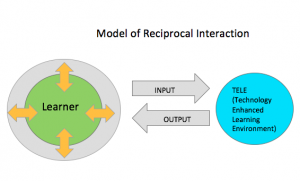Alongside the writing on The Jasper Series by Cognition and Technology Group at Vanderbilt (1992) , Shyu’s (2000) research on implementing video-based anchored instruction in Taiwan, and Vye, Goldman, Voss, Hmelo and Williams’ (1997) research on middle school students and college students working through The Big Splash, are considered in the following response.
**********
Anchored instruction is based on the theories of situated learning, cognitive apprenticeship and cooperative learning with the aim to enhance student problem-solving skills (Shyu, 2000). Anchored instruction largely involves generative learning. CTGV (1992) describes generative learning, by quoting Resnick and Resnick, as necessary for effective learning. Concepts and principles “have to be called upon over and over again as ways to link, interpret, and explain new information” (p.67). Anchored instruction situates “the instruction in meaningful problem-solving contexts that allow one to simulate in the classroom some of the advantages of apprenticeship learning (CTGV, 1992, p.67). As well, anchored instruction focuses on cooperative learning which allows for the construction of ‘communities of inquiry’ – a space for students to grow understanding through discussion, explaining, and reasoning or argumentation (CTGV, 1992; Vye et al., 1997).
One of the important nuances of anchored instruction specifically evident in the research of Vye et al. (1997) is the effectiveness of thinking out loud. In their research, two experiments were completed, the first with individual students and the second with dyads or partner groupings. In both experiments, the students were asked to perform their thinking out loud. In the first experiment, the student did not participate in any dialogue with another student, instead verbalizing ideas in monologue style. In the second experiment, the students participated in reasoning, or arguments, to reach a solution, consisting of both agreements and disagreement. The success of problem-solving through reasoning in a dyad setting is attributed speculatively to the active expressing of ideas and thinking verbally, and the monitoring of reasoning and problem solving ideas by the partner. Furthermore, the data showing goal and argument linkages indicates that “goals tend to be followed by arguments and argumentation often leads to new goals” (p.472). Interestingly, the data related to the types of arguments indicated that 33% of the arguments were positive in agreement, while 67% were negative, or disagreements, both of which often lead to a new goal (Vye et al., 1997). Considering this thinking out loud aspect of anchored instruction is transformational for math instruction in general, as math problem solving traditionally is completed visually on paper, on a technology screen, or mentally – in silence. One math resource by Sherry Parrish (2014) that I have recently acquired is entitled Number Talks: Helping Children Build Mental Math and Computation Strategies. Although digital technology is not a component of this K-5 curriculum {except for a CD-Rom with number talk sessions to instruct teachers on how to implement number talks), the physical act of talking, communicating ideas, reasoning and recognizing that there are many ways to solve a problem are premised throughout. A similar resource for grades 4-10 by Cathy Humphreys and Ruth Parker (2015) is entitled Making Number Talks Matter. Both of these resources do incorporate problem solving, but not in the same way as the video-based anchored instruction highlighted in the readings – problem solving is very much computational, rather than real-life scenarios and these math talk conversations and problem solving are dependent on access to previous knowledge, rather than generating knowledge through the problem solving. However, both math talks and anchored instruction do include ‘talking about math’, allowing for misconceptions to come to light and for students to better understand the why, when and how of mathematics. When a student is able to speak their understanding, that understanding becomes theirs to own, and becomes a tool through which they are now learning.
In closing, Vye et al. (1997) mention other problem solving enrichments that have been established by others. Following is a collected list of further inquiry readings. These readings are referenced on p.479.
References
Cognition and Technology Group at Vanderbilt (1992). The jasper experiment: An exploration of issues in learning and instructional design. Educational Technology Research and Development, (40), 1, pp.65-80.
Humphries, C. & Parker, R. (2015). Making number talks matter: Developing mathematical practices and deepening understanding, grades 4-10. United States of America: Stenhouse Publishers.
Parrish, S. (2014). Number talks: Helping Children Build Mental Math and Computation Strategies. Sausalito, California: Math Solutions.
Shyu, H.-Y. C. (2000). Using video-based anchored instruction to enhance learning: Taiwan’s experience. British Journal of Educational Technology, 31: 57–69. doi:10.1111/1467-8535.00135
Vye, N., Goldman, S., Voss, J., Hmelo, C., Williams, S., & Cognition and Technology Group at Vanderbilt. (1997). Complex Mathematical Problem Solving by Individuals and Dyads. Cognition and Instruction, 15(4), 435-484. Retrieved from http://www.jstor.org/stable/3233775


